Pernille Ripp's Blog, page 38
October 7, 2017
Recapturing the Magic of Stories – Practical Ideas for Better Creative Writing

“Do we have to write?” He looks at me and awaits my answer. I know he wants me to say no, but instead, I nod. Every day. Just try. It’ll get better. “But I hate writing…” and the kids around him nod. So many kids not considering themselves writers. So many kids who write simply because school tells them to. And I see it every time I assign a story project. I see it when they write summaries of stories rather than an actual story. I see it when they fiddle with their papers, break their pencils or write one line. We hate writing, and there is nothing you can do about it.
And yet….writing is stories. Writing is our past and our future. Writing has the power to break us apart or put us together. So when our students tell us that they hate writing, it is usually not the writing itself they hate, it is everything attached to it. All of the tasks we add in with writing to make sure they know how to write. To make sure they can write. And I wonder, once again, in our eagerness to create students who can write are we, instead, producing students who won’t?
So what can we do within our writing instruction to reignite or protect the writer that lingers within each child? What are ways we can help them see that writing is something we need as human beings, and not just because the teacher told us to?
We hear their truths.
Much like we must uncover what protects or demolishes their love of reading, we must ask the hard questions about writing too. Why do you think you are not a writer? When is writing hard? When is writing amazing? How can I be a better teacher of writing for you? And then we take those truths with us, we unpack them and then we reflect on our teaching practices; what have we done that have done damage? How can we navigate all of our requirements without doing irreparable harm?
We make it a priority.
I know we do a lot of writing but how much of that is process writing; summarizing, essays, analysis, informational writing. Where is the creative writing? I know when I taught 5th grade it was the final unit of the year. If we got to it, that is. Why not start with them finding their writer’s voice. Tell them to write a story, either real or fictional. and reconnect them with their storytelling skills. Begin the year with free writing and maintain it throughout the year. Don’t save it until the end of the year when we can have done so much damage already.
We give them time.
We cannot create writing opportunities in our classrooms without dedicated time. And I don’t mean the writing instruction slot where they are working on their assigned project, but free writing time, where they are encouraged to write whatever they want. Free writing time every day so that they get in the habit. Free writing time so they can work through what it means to be a writer and start to see the small success that will carry them forward. Whether it is ten solid minutes like it is in my Informational Studies class or even just four minutes like it was last year for me. Time should be dedicated to free writing every single day, even if you only have 45-minute classes.
We give them freedom.
Every day we tell our kids to write something in their writer’s notebook. We offer up a prompt but we also tell them they don’t have to use it. And then we step back, encourage them to write, but nothing else. This is about them, not us.
We tell stories.
Great writing starts with stories, so we tell our own stories and model what it means to capture an audience. We have them share their own stories as they practice how to hold an audience captive. We do speeches so they can see what grabs people’s attention and what doesn’t. Through the stories we tell we encourage them to write someday, to find ideas for writing.
We withhold judgment.
Every few weeks I look through their writer’s notebooks just to get to know them. I don’t assess, I don’t correct. Instead, I write comments, genuine reactions to what they have written so they know I am reading. But I do not tell them how to be a writer, not here, not now. That writer’s journal is exactly that; a journal, not an assignment. And so some write comics, others journal, some writ lengthy stories. Poetry, scribbling, moments of their lives burst at me from their pages and I hope that within all of their ideas they start to see what writing really is; an extension of self, of who we are and an exploration of how we fit in.
We bring authors in.
Many of my students are under the impression that “real” writers knew they were writers from a young age. That story ideas just come to them. that they sit down and a whole book just flows from their fingers. But that’s often not the case at all. how do I know? Because “real” writers have been speaking to my students via Skype for the last few years. And they dispel their writing myths one at a time. It turns out there is no one right writing process. There is not a right way to write. Inspiration comes from many places. And it also turns out that writing is hard work. That getting the idea is often the smallest part but the actual revising and cutting out and making better is where the work comes in. They don’t believe me when I say these things always but when authors do, they start to.
We are real writers.
How many of us teach writing but don’t write ourselves? How many of us create our modeled texts at home because we know it will be hard to do it on the spot in front of the kids? How many of us would never consider ourselves writers but then expect our students to be? Be a writer yourself, it doesn’t have to be published, but go through the process and do it authentically. Share how hard writing is for you, share your bad habits of writing, give them a real role model of what writers are so they don’t think that it is something that just happens.
We ask them who they are as writers.
And we come back to the question throughout the year. We ask them to explore what writing means to them. We ask them what their writing process is and we share our own. We ask them to find some sort of value in writing, not because they have to love it but because they should be at peace with it.
We have them lead the conversations.
Less checklists. Less pre-determined goals only set by the teacher. Less specific feedback that teaches them that this is the only thing they need to work on because that is all the teacher told them to work on. More student reflection, more student questions, more student ownership over how they need to grow. When we confer they should do most of the talking. When we confer they should start to find out what they need our help with, not vice versa. In the beginning, it is hard but it will never get easier if we don’t start the conversations and hand over the reigns.
We don’t give up.
Every day we write. Every day we share stories. Every day we create something. Every day we become more than what we were. And we don’t give up. We hear their truths as we gently encourage them forward. We showcase many kinds of writing. We give them freedom, trust, and a safe space to share. We tell them to share when they can and not when they don’t want to. We tell them to use our space as writers would; get comfortable, listen to music, discover your writing process. Find your writing peers so you have people you trust that will give you honest feedback.
For too long creative writing has taken a backseat to task writing and while I know we need to be able to write things that fulfill purposes, we cannot lose sight of the bigger picture here. We have to give our students opportunities to have a relationship with writing that goes beyond what the teacher told them to do. And that starts with the very decisions we make every day in our classrooms. That starts right now.
If you like what you read here, consider reading my newest book, Passionate Readers – The Art of Reaching and Engaging Every Child, out August 2017. This book focuses on the five keys we can implement into any reading community to strengthen student reading experiences, even within the 45 minute English block. If you are looking for solutions and ideas for how to re-engage all of your students consider reading my very first book Passionate Learners – How to Engage and Empower Your Students. Also, if you are wondering where I will be in the coming year or would like to have me speak, please see this page.
Filed under: being a student, being a teacher, Literacy, student choice, Student dreams, Student Engagement, student voice, writing


October 2, 2017
And Yet…
On the morning of the kickoff to the largest Global Read Aloud yet. On the morning of what should have been a happy Monday, One where more than 2 million students would connect through the invisible threads of a read aloud. One where a global project kicked off that is focused on perspective, understanding, acceptance, kindness, empathy, and everything that is good about our world, we are instead faced with the news of another mass shooting.
Once again the largest in newer US history. And I spend my day in front of my computer not checking in on the Global Read Aloud, but instead seeing the death toll rise higher, the injured numbers climb, and the desperate pleas for someone to do something.
And we do; we send our thoughts and prayers, We donate our blood, and then we say to not make it political. That now is not the time for action out of respect for the tragedy.
And yet, tomorrow I will send my children to school knowing that they have to do active shooter drills in their classrooms so that they can be prepared for the worst.
And yet, I will ask my son about these drills and he will tell me that he did a great job being quiet mom, so the “bad guy can’t get me…” And I will smile and tell him good job but inside I will rage and tremble. This is my child, these are my most precious, and they are being taught to sit silently, hoping to not become victims.
And yet, I will go through training in my own district for what I can do to try to protect the very kids I teach. I will be told I have an option to fight or to hide, and that no one will fault me for making the wrong decision.
And I will tell my friends, who sit in my home nation of Denmark, that I am afraid again. That I am not sure this country is really sane anymore. That I am not sure I am really able to protect anyone because all it takes is one person with a weapon.
And yet, this is not the time to be political. So when is it? Because I am ready, because I am afraid, and I don’t want my children to have to wonder what will happen when they go to school, or a movie theater, or a mall, or a concert, or on a plane, or walk down the street.
Filed under: being a teacher, being me


September 26, 2017
What the Test Didn’t Care About
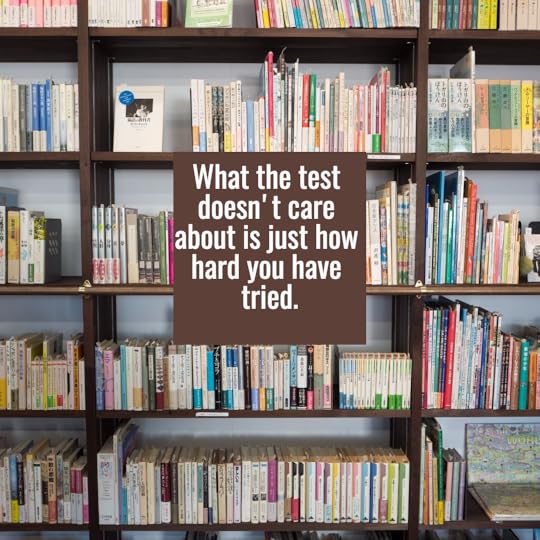
Dear Theadora,
Today you told me you were stupid. That you couldn’t even read the stupid test. That you knew you failed and so you gave up. That you will never be a reader. Again.
And I looked at you and I asked if you needed a hug. As you crept into my arms, there was so much I wanted to tell you and like your bumbling mother I tried.
I told you to remember that you are not a stupid test.
That you are not a correct answer. Or an incorrect one for that matter.
That you are not just a level, a piece of data, an insignificant number determined by a profit-making entity. You will never be just a J.
That you are not stupid.
That you are not failing.
But that you are smart.
That you are brave.
That you are a reader.
Because what the test didn’t care about is that we see you read. We see you listen. We see you choose a book and make your way through the pages, even when the words don’t make sense.
We see you ask to go to the library and please can I have one more book?
We see you read to your siblings, to ask for just one more page, to tell me everything that has happened in the Lightning Thief since I last drove the car.
We see you try, We see you fight for the words at times, and other times, they come so easily.
What the test doesn’t care about is how far you have come. How you know all of the strategies but when you know you are getting the answers wrong it doesn’t matter what you were taught because all you can think about is how you know you are wrong and now the rest of the world knows it too. How does anyone face that as a child?
What the test doesn’t care about is how much you love reading. How much your teachers work hard to protect it. How much being a reader, one that reads chapter books, means to you. Which is why you keep trying every single day, every single time.
So when we look at the data, dear Thea, I wish it told the full story. That it actually showed us what we needed to know. Not just a level. Not just a score. Not just the incorrect or the time spent struggling. Not just the suggested lessons or the gaps in your skills.
I wish it knew you. No test ever will. That is why we are so thankful for your teachers.
But I can tell you now, and you have to believe this loudly. You have to believe this proudly. You have always been a reader. You will always be a reader. Nothing will change that if you don’t let it. So don’t let it.
Love,
Mommy
Filed under: Be the change, being a teacher, being me


September 25, 2017
On Creating Reading Experiences

They groan when I tell them about the Signposts.
“Another thing to write about, Mrs. Ripp?”
“Do we have to?”
“Why can’t we just read?”
Their post-its hang behind me, reminding me of all they have said about what kills their love of reading.
And I get it, we, meaning educators, have written reading to death. With every post-it, every jot, every stop and think, every time we ask them to do more work and forget about the virtues of aesthetic reading as discussed by Louise Rosenblatt, we make them dislike it more. In our eagerness to help kids become better readers, we have made the kids drown in their post-it notes. We have broken meaningful stories into such small tasks so that the very meaning that made the story worth our time is gone. We have forgotten about the purpose of all this instruction it seems; to create literate human beings that can grow from what they read, both intellectually, but also on a heart level.
Yes, we need to teach skills, of course, we do. But we also have to let the kids use those skills in meaningful ways. We have to let them practice too without telling them to use post-its, without telling them to write down, without telling them to look for specific things, because if we don’t, we don’t know if they will ever be able to do it without our prompts, our scaffolds, our tasks. We have to remind them, and ourselves, that when we read it is not just to complete a task attached to it. That the task is just a practice for the real deal; for when we read and we have an experience with the text.
So I tell them not to worry. The signposts, or any other skills we review or learn are just tools. Tools to use when it makes sense. Tools to use so they can complete the tasks that we do need to do at times. Practice them so they become habit when we need them but that it is also okay to just read and let the movie flow in our heads to the point where the rest of the world falls away and all we can focus on is how close we are getting to the end of the book.
So let your students experience meaningful words, not just more reading tasks. Let them experience what it means to read and then feel something. Let them experience what it means to read and sit in silence. Let them read and get to the end and then discuss what the text made them think of, not just a few skills you have just taught, not just the repertoire of tools they may have. Balance is needed in all of our classrooms for the purposes of reading, our students are telling us this loudly if we will only listen.
If you like what you read here, consider reading my newest book, Passionate Readers – The Art of Reaching and Engaging Every Child, out August 2017. This book focuses on the five keys we can implement into any reading community to strengthen student reading experiences, even within the 45 minute English block. If you are looking for solutions and ideas for how to re-engage all of your students consider reading my very first book Passionate Learners – How to Engage and Empower Your Students. Also, if you are wondering where I will be in the coming year or would like to have me speak, please see this page.
Filed under: Be the change, being a teacher, Literacy, Reading, Reading Identity


September 20, 2017
When Reading is Trash or Magic
A couple of years ago I asked my students to tell me why reading was amazing. When Jack whispered to Michael that “Reading sucks…” the rest, they say, is history. Inspired by Jack’s words of truth, I have asked students for years now to tell me their reading truths and not hold back. I cannot be the kind of teacher I would like to be if I don’t get to know them. The real them. Not the school-primed, sanitized version. Not the kid that knows how to play the game. Not the kid that says whatever they think we want to hear so they start off on a good foot.
So on the third day of school this year, I told the story of Jack. Of how I had been doing that lesson where I talk about the magic of reading. How he had dared to whisper those words. Some of the students laughed, they remember the lesson I was referring to, as they have also head about how amazing reading is for years. And then they got quiet as I asked them so when is reading not magical? And when is it?
I wrote in big bold letters “Reading is magical” and then asked them what to write on the other side. “Reading is trash!” they said as they chuckled, not quite sure, I am sure, of what to make of all of this.
They grabbed as many post-its as they could and then started to write their reasons. Please tell me when reading is amazing. Please tell me when reading is trash. Tape your post-its to the board so they stay up. Sign your name if you want. And then step back, read the post-its. What do you notice?
[image error]
Over and over their words joined together to form the same patterns I see year after year. The same things I have done to kids through the years. The same things many of us educators are told to do every year by well-meaning administrators who are led by an expert curriculum that someone told them to purchase to raise test scores.
No choice!
Boring books!
Too much writing!
Tests!
Forced reflections!
Sitting still!
Their words glared at us.
[image error] [image error][image error] [image error] [image error] [image error]
But wait? When is reading magical? Again a pattern that we all know.
When I find the right book!
When I am given time to read!
When I find a great series or author!
When it is quiet!
When I am allowed to just read!
[image error] [image error][image error] [image error][image error]
Their words have carried us into our beginning reading conversations, into our analysis, into our very community. They have guided us as we start to figure out where reading fits into our lives and whether we can protect or promote a strong and personal relationship with reading. They have guided us as they have mentioned the amazing experiences they have had with their previous teachers, and the ones they wish that had not had.
We fret so much over what curriculum we should use, how we should teach, and how we should grade, yet sometimes the biggest impact we can have with kids is simply when we stop and ask them for their truths. Do you know what your students would say?
PS: This lesson and the others that surround it are all discussed in my new book, Passionate Readers. Passionate Readers.
If you like what you read here, consider reading my newest book, Passionate Readers – The Art of Reaching and Engaging Every Child, out August 2017. This book focuses on the five keys we can implement into any reading community to strengthen student reading experiences, even within the 45 minute English block. If you are looking for solutions and ideas for how to re-engage all of your students consider reading my very first book Passionate Learners – How to Engage and Empower Your Students. Also, if you are wondering where I will be in the coming year or would like to have me speak, please see this page.
Filed under: Be the change, being a teacher, Literacy, Reading, Reading Identity, student choice, Student dreams, student driven, student voice


September 17, 2017
On Authentic Reading Goals and Conversations
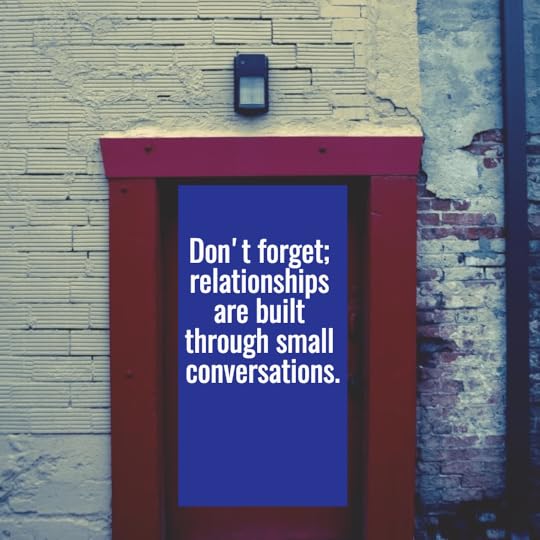
The silence envelops us a few minutes into class. I look around and see one of my favorite sights in the world; kids reading. Quietly I walk up to the first kid, grab a chair, sit next to them and ask; what is your goal for the year? And for the next few minutes, I get to know this child a little more, not just as a reader, but also as a human being.
Last week, I wrote about our the changes to our 7th- grade reading challenge and how this year we had decided to move away from just quantity to make it more authentic for students. I was excited to roll it out but not sure how the students would react. Were they even up for a challenge or would it just be another thing to get done just so the teacher would stop bugging them? Only one way to find out; ask them.
This week, as I started my quick reading check-ins, asking about their goal, has been the main topic of conversation. With a simple question, we are off and I am starting to get a feel for these kids and who they are as readers.
So what have I noticed?
That no goal fits all. As an elementary teacher, I often provided my students with a specific goal for them to work on and while instructionally this makes sense, after all, I can see what they need to work on, there often was very little buy-in. When students reflect on their own needs and set a goal, they immediately see the reason for it. Those goals that I also see for them? We will work on them together in a small group.
That when we ask kids to really think about what they need to work on the answers are very varied. This also means that the years I have pushed for more of a quality goal or other single-minded goals, that many kids have not bought into it because the goal has not mattered to them. Some kids immediately had something come to mind, while others needed more support. Most kids though have created a goal that is specific to not just their reading identities, but also their reading lives.
Those individual goals encourage more honesty. I always operate under a policy of total honesty when it comes to reading and ask my students to also do so. By starting our reading conversations early in the year and asking for them to tell me the good and the bad as far as their reading experiences, that judgment-free reading discussion follows us into their goal setting. When I ask students why they chose that goal, many discuss how or when they read or when they don’t and why they need to change that. Some kids also discuss how even with this goal they don’t think they will be successful because of various obstacles. Rather than hiding these thoughts, they are willing to share them which means I can now note it and try to do something about it.
That they do most of the talking. While I start the conversation and also offer up follow-up conversations, I need to make sure that it is their response that guides the path. Too often I have overtaken a conversation out of my own helpfulness, but now I try to listen and then respond to get them to elaborate.
Those relationships are built in small pieces. One of the best benefits of these reading check-ins simply has to do with relationship building. Every time I am able to devote a few minutes to just one child that is one child I know better. While this might be a “Well duh” moment, I often think of how many conversations we don’t make time for especially in middle school and high school. How often do we feel like we don’t have time for that check-in or small group because we have so much to cover? The reading check-in is a foundation of my further instruction and I need to remember that when I feel like I am pulled in a different direction.
That quantity goals often mean that the child does not know themselves well as a reader. While quantity goals used to be our norm, I have found in my conversations that often when a child now sets the minimum quantity goal it is often because they do not know what else to work on. Our reading check-in then centers around what else they could focus on. When they are not sure then that tells me a lot about their reading identity.
That reading check-ins offer me a chance to remind. Those first few days of school are such a blur for all of us and I shudder to think of all of the information that these students have been presented within all of our classes. So while I offer reminders in the beginning of class, I am also reminding them of reading rights as we speak. It is important that kids know that they can book shop anytime they want, that they can abandon any book they need to, and that they need to plan for reading throughout their day. How many times do we say things in those first few days that kids never hear?
That I write very little down. Too often we get caught up in our conferring notes, rather than in the conversation itself. I am intentionally limiting my notes just so I can focus on the child, so I can look them in the eye, react to what they are saying and then jot a few things down that can spark the next conversation. (To see the form I use, go to our Facebook group).
As I think ahead to the coming week, I am excited. Excited to have more conversations. Excited to move further in our instruction. Excited to learn more about these kids that have been entrusted to me every day. All through one little goal and a few minutes of conversation.
PS: If you would like to have more reading conversations or you have questions, come join our Passionate Readers Facebook group,
If you like what you read here, consider reading my newest book, Passionate Readers – The Art of Reaching and Engaging Every Child, out August 2017. This book focuses on the five keys we can implement into any reading community to strengthen student reading experiences, even within the 45 minute English block. If you are looking for solutions and ideas for how to re-engage all of your students consider reading my very first book Passionate Learners – How to Engage and Empower Your Students. Also, if you are wondering where I will be in the coming year or would like to have me speak, please see this page.
Filed under: being a teacher, Literacy, Reading, Reading Identity, student choice, Student dreams, student driven, student voice


September 13, 2017
Finding Our Voices Again
It has been six full school days.
Six days of remembering names and sometimes still getting it wrong.
Six days of questions. Of answers. Of repeated directions and pointing to the right place. Of saying yes more than no, of smiling wide to make sure they all see it.
It has been six days of feeling like everything is taking a long time. Of not getting enough done. Of not having any assessments yet and feeling like already I am behind.
And yet…
In those six days, we have read our own books, perhaps even abandoned a few.
We have discussed why reading is trash or magic.
We have set goals that matter to us and fit our needs.
We have started our reading check ins as we figure each other out.
And we have talked. A lot.
I have withstood the urge to have them write their answers and instead just talk it out.
I have withstood the need for silence and seen where the conversation will take us.
I have withstood my own imposed pressure of having them produce something in order for me to say; look I taught them something.
Every day instead of finding our pencils, we have instead found our voices and shared with each other. We have pondered. We have sighed. We have even been shocked.
The writing will happen. The assessment will too. But for now, we are speaking up instead of writing down as we figure out how this learning community is going to work. We are finding ourselves in the cacophony of thoughts and we are finding each other as well.
If you like what you read here, consider reading my newest book, Passionate Readers – The Art of Reaching and Engaging Every Child, out August 2017. This book focuses on the five keys we can implement into any reading community to strengthen student reading experiences, even within the 45 minute English block. If you are looking for solutions and ideas for how to re-engage all of your students consider reading my very first book Passionate Learners – How to Engage and Empower Your Students. Also, if you are wondering where I will be in the coming year or would like to have me speak, please see this page.
Filed under: being a student, being a teacher, student choice, Student Engagement, student voice


September 9, 2017
The 7th Grade Book Challenge Revisited
33% of my 118 7th graders told me they had not read a single book last summer. That books were just not their thing or they were simply too busy. 33%…Many of them told me they had read the book club books they had been assigned the year before but not that much else. Some told me they had fake read most of their way through years prior, averaging 1 to 2 books a year if even. Some told me how much they loved books, that their summers were spent with their nose in pages because what else would you do when you have all of the time in the world
Teaching 7th graders has taught me many things, but one of the biggest is the incredible need to inspire a larger love of reading in more of their lives. Not because teachers before them haven’t, but because for some reason it hasn’t completely stuck for all of them. So that becomes our mission; for the students to fall in love with reading or at the very least hate it less.
When I read the Book Whisperer by Donalyn Miller, it significantly changed my reading instruction as a teacher. Coupled with other landmark books for me such as The Daily Five by The Two Sisters, and also Mosaic of Thought by Elin Keene and Susan Zimmerman, I finally felt like I had a path I could follow when it came to the aspiration of reading. It was as if I did not know how high of expectations I could hold my students to until after I read these books. Donalyn’s 40 Book Challenge became a central tenet of my instruction, not as a requirement, but as a way for my students to challenge themselves. While I made tweaks because that is what reflective teachers do, I stayed true to its original intent; to challenge my students to read voraciously, based on the research that Donalyn cites in her book that kids who score in the 90th percentile of reading tests read between 30-40 books a year. I did not offer incentives. I did not do logs. I did not tell my less developed readers that their goals should be less because there was no way they could accomplish 40 books. I asked them to shoot for 40 or more and then helped them reach their goals by giving them time to read, time to book shop, and support as they needed. Some kids made their goals, others did not, but they all read more than they had before.
I knew that when I moved to 7th grade I wanted to do the 40 Book Challenge but I was also faced with the incredible limitation of 45-minute instructional blocks. 45 minutes to do everything. 45 minutes that only allowed me to give them 10 measly minutes of reading, rather than the 30 we had enjoyed in 5th grade. After my first week with my 7th graders, I decided to change the language of the challenge in the beginning to 25 books rather than the 40, not because I did not believe that my 7th graders could not read 40 books, but because for some, simply saying 40 in the beginning seemed completely un-doable, especially because I could only give them 10 minutes of reading time every day. However, if I had 60 minutes or more, I would still start with 40 books, after all with that amount of time kids should be given at least 20 minutes of reading every day. But the idea remained; this was a challenge, something to strive for, something to work toward, and something that I believe all of my students can reach if we help them have successful reading experiences.
It appears that some believe that because I have called this the 25 book challenge in the past that that means I want my students to only read 25 books. That somehow the original 40 book challenge is too hard for kids. Neither of these statements are true. All kids should be challenged to read 40 books or more. I believe all of my students can read more than 25 books, my job is often to help them believe it too. But just as in the original, it is not really about reaching the quantity set, it is about having incredible reading experiences.
As the year goes on we, therefore, adjust our goal, some continue to focus on the quantity while others change their focus either to different genres, harder vocabulary or even formats that they have not dabbled in before. While some kids continue to focus on quantity, and for them we do the following breakdown for how books count, for others the challenge morphs into figuring out how they can push themselves as readers beyond a quantity standpoint. (To see more about this read about the reading identity challenge).
Books under 200 pages count as 1 book
Books over 200 pages count as 2 books
Books over 500 pages count as 3 books
Books more than 750 – see the teacher
Depending on its size a graphic novel may count as a whole, half or quarter of a book.
10 of the books have to be chapter books
If this goal is not high enough for a learner, they set a higher goal
They write down their titles in a reader’s notebook we keep at school and update it every Monday or whenever needed.
I do not ask them to read certain genres but instead take this as an opportunity for them to explore themselves as readers and figure out what they love to read. I constantly book talk books, as do they once we get rolling, and I am constantly sharing recommendations to individual students. We practice free book abandonment, making sure that the books we read are books we actually want to read, and we book shop monthly if not more. Our to-be-read lists are extensions of our reading life and are used weekly, if not daily.
After three years with 7th-grade book challenge, I can tell you, it works. I am not surprised, after all, Donalyn Miller and her ideas have never let me down. While not all kids reach their goals, many do, and many of those who did, never thought they would. Yet the biggest success is not just the kids that reach their goal but within the kids that don’t. As one child told me on his reading survey, “…I even read a book at home for fun, I had never done that before.” That child’s number? Five more than the year before. Five more great books that he loved so much he book talked them to others. Books that gave him such a great experience that he continues to chase that feeling again.
I will not pretend that it worked for everyone, there are always kids that issuing a challenge will not work for, where what we did together was not enough, but there are so many that it made a difference for. Where the expectation to read every single day and reach a certain goal that mattered to them meant that they turned up their reading, that they selected their books more carefully, that they spent a longer stretch reading then they normally would have.
So for the 118 7th graders that I teach, I am so grateful that they believed me when I told then, “Yes, you can read more books.” But do not take my word for it; let these pictures show you what it looks like when 7th graders read and become readers. Let these pictures show you that yes we can get kids at this age to read, that just because a child is going through huge personal development reading does not have to become not lost. What matters is the reading community we create. And the high expectations we have for all of our kids. [image error][image error][image error][image error][image error]
And in case you are wondering, that is 4,357.5 books. Not bad for how many kids told me that reading was not something they felt like doing.
If you like what you read here, consider reading my newest book, Passionate Readers – The Art of Reaching and Engaging Every Child, out August 2017. This book focuses on the five keys we can implement into any reading community to strengthen student reading experiences, even within the 45 minute English block. If you are looking for solutions and ideas for how to re-engage all of your students consider reading my very first book Passionate Learners – How to Engage and Empower Your Students. Also, if you are wondering where I will be in the coming year or would like to have me speak, please see this page.
Filed under: being a teacher, Reading, Reading Identity


September 8, 2017
A Few Books about 9/11
Monday marks another anniversary of 9/11, a tragic day in American history. As I prepare my lesson for Monday, I am so thankful to the authors that have made it easier for us to discuss the events of 9/11 with our students through the books they write. I thought it would be nice to have a resource here, in case you need a few book ideas for your library.
Picture Books:
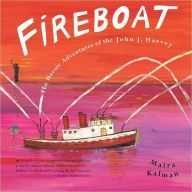
Fireboat: The Heroic Adventures of the John J. Harvey by Maira Kalman was new to me this year. A mighty little story indeed.
From Goodreads:
This is the inspiring true story of the John J. Harvey—a retired New York City fireboat reinstated on September 11, 2001. Originally launched in 1931, the Harvey was the most powerful fireboat of her time. After the September 11 attacks, with fire hydrants at Ground Zero inoperable and the Hudson River’s water supply critical to fighting the blaze, the fire department called on the Harvey for help. There were adjustments—forcing water into hoses by jamming soda bottles and wood into nozzles with a sledgehammer—and then the fireboat’s volunteer crew pumped much-needed water to the disaster site. The John J. Harvey proved she was still one of New York’s Bravest!
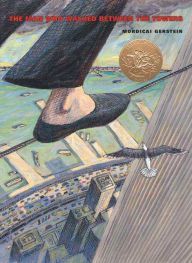
I have read aloud The Man Who Walked Between the Towers by Mordecai Gerstein the last three years. It is a powerful reminder of what there was and now what there isn’t.
From Goodreads:
In 1974, French aerialist Philippe Petit threw a tightrope between the two towers of the World Trade Center and spent an hour walking, dancing, and performing high-wire tricks a quarter mile in the sky. This picture book captures the poetry and magic of the event with a poetry of its own: lyrical words and lovely paintings that present the detail, daring, and–in two dramatic foldout spreads– the vertiginous drama of Petit’s feat.
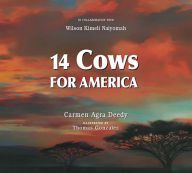
I added 14 Cows for America by Carmen Agra Deedy and Wilson Kimeli Naiyomah to our library last year. It is a powerful story that deserves to be read aloud any time of year, not just in honor of 9/11.
From Goodreads:
In June of 2002, a very unusual ceremony begins in a far-flung village in western Kenya. An American diplomat is surrounded by hundreds of Maasai people. A gift is about to be bestowed upon the American men, women, and children, and he is there to accept it. The gift is as unexpected as it is extraordinary.
A mere nine months have passed since the September 11 attacks, and hearts are raw. Tears flow freely from American and Maasai as these legendary warriors offer their gift to a grieving people half a world away.
Word of the gift will travel newswires around the globe. Many will be profoundly touched, but for Americans, this selfless gesture will have deeper meaning still. For a heartsick nation, the gift of fourteen cows emerges from the choking dust and darkness as a soft light of hope and friendship.

I do not own The Little Chapel that Stood by A.B. Curtis myself as I have yet to find a copy in my price range, but I hope to one day have it in our library.
From Goodreads:
The beautifully illustrated book tells of the historic chapel less than 100 yards from the Twin Towers that miraculously survived on 9-11. Firemen hung their shoes on the fence and raced to help the people in the towers: Oh what gallant men did we lose/Who never came back to get their shoes. The story of terror overcome by courage and bravery that teaches us no one is too small to make a difference.
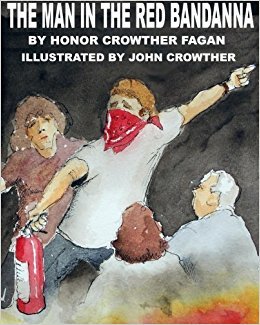
The Man in the Red Bandana by Honor Crowther Fagan and illustrated by John Crowther is the picture book I will read aloud this year.
From Goodreads:
When Welles Crowther was a young boy, his father gave him a red bandanna, which he always carried with him. On September 11, 2001, Welles Remy Crowther saved numerous people from the upper floors of the World Trade Center South Tower. “The Man in the Red Bandanna” recounts and celebrates his heroism on that day. Welles’ story carries an inspirational message that will resonate with adults as well as young children.

Published last year, Seven and a Half Tons of Steel by Janet Nolan and illustrated by Thomas Gonzalez is another remarkable picture book of resilience and what can come from a tragedy.
From Goodreads:
There is a ship, a navy ship. It is called the USS New York. It is big like other navy ships, and it sails like other navy ships, but there is something special about the USS New York. Following the events of September 11, 2001, the governor of New York gave the Navy a steel beam that was once inside one of the World Trade Towers. The beam was driven from New York to a foundry in Louisiana. Metal workers heated the beam to a high, high temperature. Chippers and grinders, painters and polishers worked on the beam for months. And then, seven and a half tons of steel, which had once been a beam in the World Trade Center, became a navy ship’s bow. This powerful story reveals how something remarkable can emerge from a devastating event.
Chapter Books:

Nine, Ten: A September 11 Story by Nora Raleigh Baskin is a wonderful middle-grade book that shares the experience of 9/11 from four different perspectives around the country.
From Goodreads:
Ask anyone: September 11, 2001, was serene and lovely, a perfect day—until a plane struck the World Trade Center.
But right now it is a few days earlier, and four kids in different parts of the country are going about their lives. Sergio, who lives in Brooklyn, is struggling to come to terms with the absentee father he hates and the grandmother he loves. Will’s father is gone, too, killed in a car accident that has left the family reeling. Naheed has never before felt uncomfortable about being Muslim, but at her new school she’s getting funny looks because of the head scarf she wears. Aimee is starting a new school in a new city and missing her mom, who has to fly to New York on business.
These four don’t know one another, but their lives are about to intersect in ways they never could have imagined. Award-winning author Nora Raleigh Baskin weaves together their stories into an unforgettable novel about that seemingly perfect September day—the day our world changed forever.
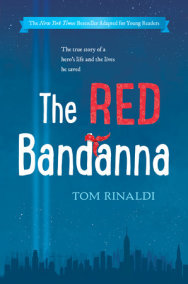
The Red Bandana by Tom Rinaldi is the young reader’s edition of the same adult book. It is quite a remarkable read of one man’s courage and ultimate sacrifice on 9/11.
From Goodreads:
On a day that changed a nation, one young man found his calling.
Welles Crowther didn’t see himself as a hero. He was just an ordinary kid who played sports, volunteered for the fire department in his town, and eventually headed off to college and then to Wall Street to start a career. Throughout it all, he always kept a red bandanna in his pocket, a gift from his father when he was little.
On September 11, 2001, Welles was at his job on the 104th floor of the South Tower of the World Trade Center when the Twin Towers were attacked. What he did next would alter the course of many lives.
That day, the legend of the Man in the Red Bandanna was born.
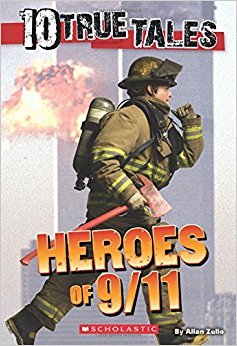
I do so appreciate the 10 True Tales series and how they added Heroes of 9/11 by Allan Zullo to their collection.
From Goodreads:
When Captain Jay Jonas of the Fire Department of New York hears an emergency radio message about the World Trade Center, he has no idea of the terrible conditions he and his team will face. Arriving at the burning building, the firefighters must summon all their courage. On the same morning, just outside Washington, D.C., a jetliner piloted by terrorists slams into the Pentagon. Can Colonel Philip McNair save lives inside the flaming building?

Lauren Tarshis does another great job with her research and storytelling in I Survived the Attacks of September 11, 2001.
From Goodreads:
The only thing Lucas loves more than football is his Uncle Benny, his dad’s best friend at the fire department where they both work. Benny taught Lucas everything about football. So when Lucas’s parents decide the sport is too dangerous and he needs to quit, Lucas has to talk to his biggest fan.
So the next morning, Lucas takes the train to the city instead of the bus to school. It’s a bright, beautiful day in New York. But just as Lucas arrives at his uncle’s firehouse, everything changes — and nothing will ever be the same again.
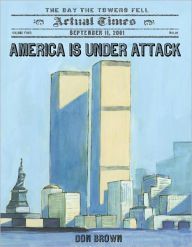
Again geared toward a younger audience, America is Under Attack by Don Brown does a marvelous job of explaining everything in a kid understandable way all in the span of 64 pages.
From Goodreads:
On the ten year anniversary of the September 11 tragedy, a straightforward and sensitive book for a generation of readers too young to remember that terrible day.
The events of September 11, 2001 changed the world forever. In the fourth installment of the Actual Times series, Don Brown narrates the events of the day in a way that is both accessible and understandable for young readers. Straightforward and honest, this account moves chronologically through the morning, from the terrorist plane hijackings to the crashes at the World Trade Center, the Pentagon, and Pennsylvania; from the rescue operations at the WTC site in New York City to the collapse of the buildings. Vivid watercolor illustrations capture the emotion and pathos of the tragedy making this an important book about an unforgettable day in American history.
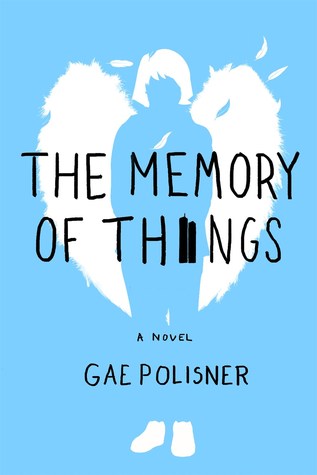
Geared toward middle school and up, The Memory of Things by Gae Polisner is unlike any 9/11 book I have read. Part mystery and gripping tale, this story leaves you wanting more until the last page.
From Goodreads:
On the morning of September 11, 2001, sixteen-year-old Kyle Donohue watches the first twin tower come down from the window of Stuyvesant High School. Moments later, terrified and fleeing home to safety across the Brooklyn Bridge, he stumbles across a girl perched in the shadows, covered in ash, and wearing a pair of costume wings. With his mother and sister in California and unable to reach his father, a NYC detective likely on his way to the disaster, Kyle makes the split-second decision to bring the girl home. What follows is their story, told in alternating points of view, as Kyle tries to unravel the mystery of the girl so he can return her to her family. But what if the girl has forgotten everything, even her own name? And what if the more Kyle gets to know her, the less he wants her to go home?
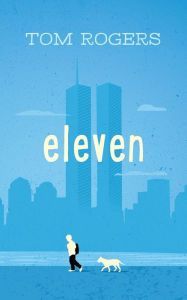
Tom Roger’s book Eleven is my favorite 9/11 book, which is a weird thing to say. The story just works so well, leaving your heart in a tight vise until the very last page. This is also a very powerful read aloud for middle grade and middle school.
From Goodreads:
Alex Douglas always wanted to be a hero. But nothing heroic ever happened to Alex. Nothing, that is, until his eleventh birthday. When Alex rescues a stray dog as a birthday gift to himself, he doesn’t think his life can get much better. Radar, his new dog, pretty much feels the same way. But this day has bigger things in store for both of them.
This is a story about bullies and heroes. About tragedy and hope. About enemies with two legs and friends with four, and pesky little sisters and cranky old men, and an unexpected lesson in kindness delivered with a slice of pizza. This is Eleven: the journey of a boy turning eleven on 9/11.

Told in the present time Towers Falling by Jewell Parker Rhodes not only speaks of 9/11 but of family, of trauma, of hope.
From Goodreads:
When her fifth-grade teacher hints that a series of lessons about home and community will culminate with one big answer about two tall towers once visible outside their classroom window, Dèja can’t help but feel confused. She sets off on a journey of discovery, with new friends Ben and Sabeen by her side. But just as she gets closer to answering big questions about who she is, what America means, and how communities can grow (and heal), she uncovers new questions, too. Like, why does Pop get so angry when she brings up anything about the towers?
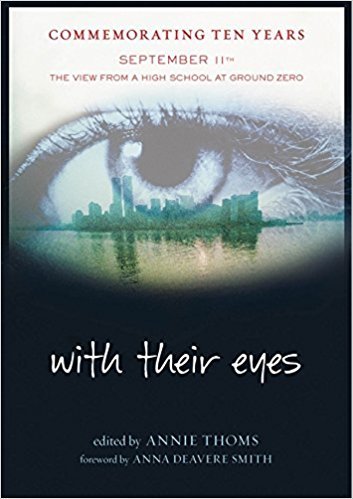
With Their Eyes edited by Annie Thoms is an essay collection by high school students at Stuyvesant High School who witnessed the attack firsthand.
From Goodreads:
Tuesday, September 11, started off like any other day at Stuyvesant High School, located only a few blocks away from the World Trade Center.
The semester was just beginning, and the students, faculty, and staff were ready to start a new year. But within a few hours on that Tuesday morning, they would share an experience that would transform their lives—and the lives of all Americans.
These powerful essays by the students of Stuyvesant High School remember those who were lost and those who were forced to witness this tragedy. Here, in their own words, are the firsthand stories of a day we will never forget.

I just ordered the 9/11 Report – the Graphic Adaptation for my own reading. Created with the desire to have more people understand what the findings were of the report, this book is sure to keep older readers interested.
From Goodreads:
On December 5, 2005, the 9/11 Commission issued its final report card on the government’s fulfillment of the recommendations issued in July 2004: one A, twelve Bs, nine Cs, twelve Ds, three Fs, and four incompletes. Here is stunning evidence that Sid Jacobson and Ernie Colón, with more than sixty years of experience in the comic-book industry between them, were right: far, far too few Americans have read, grasped, and demanded action on the Commission’s investigation into the events of that tragic day and the lessons America must learn.
Using every skill and storytelling method Jacobson and Colón have learned over the decades, they have produced the most accessible version of the 9/11 Report. Jacobson’s text frequently follows word for word the original report, faithfully captures its investigative thoroughness and covers its entire scope, even including the Commission’s final report card. Colón’s stunning artwork powerfully conveys the facts, insights, and urgency of the original. Published on the fifth anniversary of the terrorist attacks on the United States, an event that has left no aspect of American foreign or domestic policy untouched, The 9/11 Report puts at every American’s fingertips the most defining event of the century.
I know I have missed some. Which other books are out there to help us teach 9/11?
PS: To see all of our favorite books, go here.
Filed under: being a teacher, books, picture books


September 1, 2017
My Favorite Reads Summer 2017
While it feels like my to-be-read pile has not shrunk, looking back at my Goodreads, I can see that I did manage to read quite a few books. And while almost all were good, a few stood out.

My students have loved The Great Greene Heist by Varian Johnson for a long time and for some reason I had never cracked it open myself. That was a mistake. What a fun middle grade read this was!
From Goodreads:
Saving the school — one con at a time.
Jackson Greene has reformed. No, really he has. He became famous for the Shakedown at Shimmering Hills, and everyone still talks about the Blitz at the Fitz…. But after the disaster of the Mid-Day PDA, he swore off scheming and conning for good.
Then Keith Sinclair — loser of the Blitz — announces he’s running for school president, against Jackson’s former best friend Gaby de la Cruz. Gaby hasn’t talked to Jackson since the PDA, and he knows she won’t welcome his involvement. But he also knows Keith has “connections” to the principal, which could win him the election whatever the vote count.
So Jackson assembles a crack team to ensure the election is done right: Hashemi Larijani, tech genius. Victor Cho, bankroll. Megan Feldman, science goddess and cheerleader. Charlie de la Cruz, point man. Together they devise a plan that will bring Keith down once and for all. Yet as Jackson draws closer to Gaby again, he realizes the election isn’t the only thing he wants to win.

How do you tell others to read a book about child abuse knowing that it will probably make them cry? You just do. The Summer of Owen Todd by Tony Abbott comes out October 17th and is a must add for middle school classrooms and up. While the topic may be harrowing this is one of those books that could actually save a life.
From Goodreads:
Owen and his best friend, Sean, are both eleven years old. They’ve lived on Cape Cod all their lives, and now that they’re a little older, they’ll finally be free to spend some time on their own. But Sean’s mother has a different idea–she hires a babysitter to look after Sean. Paul is in his twenties, and a well-liked guy from church.
Paul starts doing things that just feel wrong. Because they’ve always been as close as brothers, Sean tells Owen, and no one else. What’s not certain to Owen is what he should do. Sean warns him not to tell anyone what is happening. But if Owen doesn’t tell, could something even worse happen to Sean?

A page-turner that starts from the back and moves forward kept me riveted while on vacation. While perhaps not the most original story, I know that Genuine Fraud will entice many of my students. Middle school and up.
From Goodreads:
The story of a young woman whose diabolical smarts are her ticket into a charmed life. But how many times can someone reinvent themselves? You be the judge.
Imogen is a runaway heiress, an orphan, a cook, and a cheat.
Jule is a fighter, a social chameleon, and an athlete.
An intense friendship. A disappearance. A murder, or maybe two.
A bad romance, or maybe three.
Blunt objects, disguises, blood, and chocolate. The American dream, superheroes, spies, and villains.
A girl who refuses to give people what they want from her.
A girl who refuses to be the person she once was.

Elly Swartz is quickly becoming a trusted author for me. Her first book, Finding Perfect, was a Global Read Aloud finalist and Smart Cookie is another amazing middle grade read. Out in January, 2018.
From Goodreads:
Frankie knows she’ll be in big trouble if Dad discovers she secretly posted a dating profile for him online. But she’s determined to find him a wife, even if she ends up grounded for life. Frankie wants what she had before Mom died. A family of three. Two is a pair of socks or the wheels on a bicycle or a busy weekend at the B&B where Frankie and Dad live. Three is a family. And Frankie’s is missing a piece.
But Operation Mom is harder to pull off than Frankie expects. None of the Possibles are very momish, the B&B’s guests keep canceling, Frankie’s getting the silent treatment from her once best friend, and there’s a maybe-ghost hanging around. Worst of all, Gram and Dad are definitely hiding secrets of their own.
If a smart cookie like Frankie wants to save the B&B and find her missing piece, she’s going to have to figure out what secrets are worth keeping and when it’s time to let go.

I have tweeted repeatedly about Miles Morales, Jason Reynold’s foray into the Marvel universe. Not only is it Spiderman, but it also has some pretty important messages for its readers about how we view others. Middle Grade and up.
From Goodreads:
Miles Morales is just your average teenager. Dinner every Sunday with his parents, chilling out playing old-school video games with his best friend, Ganke, crushing on brainy, beautiful poet Alicia. He’s even got a scholarship spot at the prestigious Brooklyn Visions Academy. Oh yeah, and he’s Spider Man.
But lately, Miles’s spidey-sense has been on the fritz. When a misunderstanding leads to his suspension from school, Miles begins to question his abilities. After all, his dad and uncle were Brooklyn jack-boys with criminal records. Maybe kids like Miles aren’t meant to be superheroes. Maybe Miles should take his dad’s advice and focus on saving himself.
As Miles tries to get his school life back on track, he can’t shake the vivid nightmares that continue to haunt him. Nor can he avoid the relentless buzz of his spidey-sense every day in history class, amidst his teacher’s lectures on the historical “benefits” of slavery and the importance of the modern-day prison system. But after his scholarship is threatened, Miles uncovers a chilling plot, one that puts his friends, his neighborhood, and himself at risk.
It’s time for Miles to suit up.

A book about periods? Yup! Well written, humorous and very informational, how many girls wish we had books like this in our libraries when they first enter puberty? Helloflo, The Guide, Period is out October 17th.
From Goodreads:
Honest, funny, and unafraid of the messy, real-life facts about a girl’s changing body, this is definitely not your mother’s puberty book. HelloFlo founder Naama Bloom’s mission is to create informed, empowered young women who are unafraid to ask questions and make the best choices for themselves and their bodies. A celebration of women’s bodies and all the confusing, uncomfortable, silly, transformative, and powerful changes that occur during puberty.
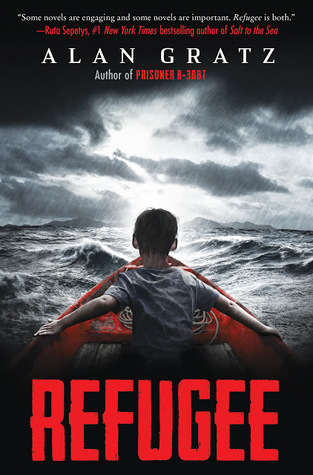
Refugee by Alan Gratz is one of my three must-read books for 2017. It was a bad idea reading this on an airplane, as this book kicks you right in the heart. 5th grade and up.
From Goodreads:
JOSEF is a Jewish boy living in 1930s Nazi Germany. With the threat of concentration camps looming, he and his family board a ship bound for the other side of the world . . .
ISABEL is a Cuban girl in 1994. With riots and unrest plaguing her country, she and her family set out on a raft, hoping to find safety in America . . .
MAHMOUD is a Syrian boy in 2015. With his homeland torn apart by violence and destruction, he and his family begin a long trek toward Europe . . .
All three kids go on harrowing journeys in search of refuge. All will face unimaginable dangers — from drownings to bombings to betrayals. But there is always the hope of tomorrow. And although Josef, Isabel, and Mahmoud are separated by continents and decades, their stories will tie together in the end.

A book about growing up in the 80’s with the threat of nuclear war hanging over you, about figuring out how two seemingly different cultures fit into you, about figuring out your friends and who you want to be. I loved This is Just a Test, great for middle-grade and up.
From Goodreads:
David Da-Wei Horowitz has a lot on his plate. Preparing for his upcoming bar mitzvah would be enough work even if it didn’t involve trying to please his Jewish and Chinese grandmothers, who argue about everything. But David just wants everyone to be happy.
That includes his friend Scott, who is determined to win their upcoming trivia tournament but doesn’t like their teammate — and David’s best friend — Hector. Scott and David begin digging a fallout shelter just in case this Cold War stuff with the Soviets turns south… but David’s not so convinced he wants to spend forever in an underground bunker with Scott. Maybe it would be better if Hector and Kelli Ann came with them. But that would mean David has to figure out how to stand up for Hector and talk to Kelli Ann. Some days, surviving nuclear war feels like the least of David’s problems.
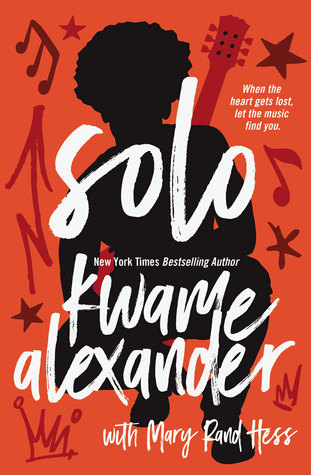
I think we can all agree that Kwame Alexander is a living master when it comes to the free verse form and Solo, his newest book, is more proof. Immerse yourself in the music as you read for a deeper reading experience. 7th grade and up.
From Goodreads:
Solo, a YA novel in poetic verse, tells the story of seventeen-year-old Blade Morrison, whose life is bombarded with scathing tabloids and a father struggling with just about every addiction under the sun—including a desperate desire to make a comeback. Haunted by memories of his mother and his family’s ruin, Blade’s only hope is in the forbidden love of his girlfriend. But when he discovers a deeply protected family secret, Blade sets out on a journey across the globe that will change everything he thought to be true.

A moving story of death, of friendship, of figuring out what is right, and also about one’s identity, All Three Stooges by Erica S. Perl comes out in January 2018 and is well-worth your pre-order. 4th or 5th grade and up.
From Goodreads:
Spoiler alert: This book is not about the Three Stooges. It’s about Noah and Dash, two seventh graders who are best friends and comedy junkies. That is, they were best friends, until Dash’s father died suddenly and Dash shut Noah out. Which Noah deserved, according to Noa, the girl who, annoyingly, shares both his name and his bar mitzvah day.
Now Noah’s confusion, frustration, and determination to get through to Dash are threatening to destroy more than just their friendship. But what choice does he have? As Noah sees it, sometimes you need to risk losing everything, even your sense of humor, to prove that gone doesn’t have to mean “gone for good.”
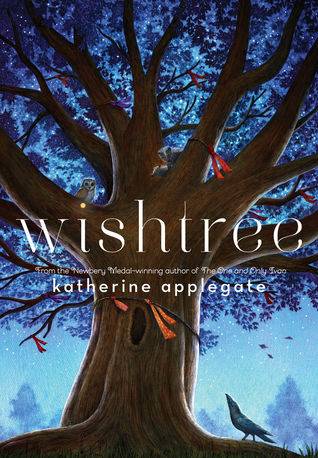
The much-anticipated release Wishtree from Katherine Applegate lives up to all of the hype. Sparse, beautiful, and told from the perspective of the tree in the backyard, life around this tree unfolds in an unexpected way. Out September 26th, 4th grade and up.
From Goodreads:
Trees can’t tell jokes, but they can certainly tell stories. . . .
Red is an oak tree who is many rings old. Red is the neighborhood “wishtree”—people write their wishes on pieces of cloth and tie them to Red’s branches. Along with her crow friend Bongo and other animals who seek refuge in Red’s hollows, this “wishtree” watches over the neighborhood.
You might say Red has seen it all. Until a new family moves in. Not everyone is welcoming, and Red’s experiences as a wishtree are more important than ever.

I don’t know how I have been a teacher and never read a Gordon Korman book before? I am so glad that has now been remedied with Restart. This middle-grade book is sure to pull in those kids who identify as not liking reading and is also a Global Read Aloud 2018 contender.
From Goodreads:
Chase’s memory just went out the window.
Chase doesn’t remember falling off the roof. He doesn’t remember hitting his head. He doesn’t, in fact, remember anything. He wakes up in a hospital room and suddenly has to learn his whole life all over again . . . starting with his own name.
He knows he’s Chase. But who is Chase? When he gets back to school, he sees that different kids have very different reactions to his return.
Some kids treat him like a hero. Some kids are clearly afraid of him.
One girl in particular is so angry with him that she pours her frozen yogurt on his head the first chance she gets.
Pretty soon, it’s not only a question of who Chase is–it’s a question of who he was . . . and who he’s going to be.
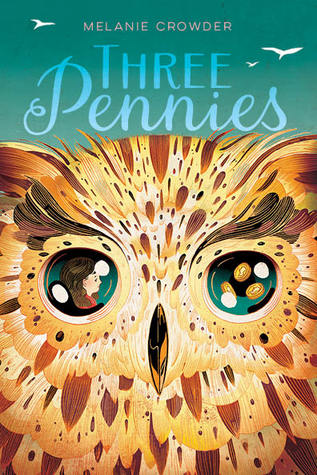
But what if your dream is not to be adopted but instead to find your mother and make her see all that she is missing? Three Pennies, Global Read Aloud 2018 contender, explores just that. 4th grade and up.
From Goodreads:
For a kid bouncing from foster home to foster home, The Book of Changes is the perfect companion. That’s why Marin carries three pennies and a pocket-sized I Ching with her everywhere she goes. Yet when everything in her life suddenly starts changing—when Marin lands in a foster home that feels like somewhere she could stay, maybe forever—the pennies don’t have any answers for her.
Marin is positive that all the wrongs in her life will be made right if only she can find her birth mother and convince her that they belong together. Marin is close, oh so close—until she gets some unwelcome news and her resolve, like the uneasy Earth far beneath the city of San Francisco, is shaken.

Thea and I devoured A Tale of Two Kitties in one day and then laughed for a long time. Dav Pilkey is a master, enough said.
From Goodreads:
He was the best of dogs… He was the worst of dogs… It was the age of invention… It was the season of surprise… It was the eve of supa sadness… It was the dawn of hope… Dog Man, the newest hero from the creator of Captain Underpants, hasn’t always been a paws-itive addition to the police force. While he can muzzle miscreants, he tends to leave a slick of slobber in his wake! This time, Petey the cat’s dragged in a tiny bit of trouble — a double in the form of a super-cute kitten. Dog Man will have to work twice as hard to bust these furballs and remain top dog!

If this post was a list in order of favorites, Dear Martin by Nic Stone would be at the top. In fact, this begs for a re-read as I want to continue to think about this book, another Global Read Aloud 2018 contender. 7th grade and up.
From Goodreads:
Justyce McAllister is top of his class, captain of the debate team, and set for the Ivy League next year—but none of that matters to the police officer who just put him in handcuffs. He is eventually released without charges (or an apology), but the incident has Justyce spooked. Despite leaving his rough neighborhood, he can’t seem to escape the scorn of his former peers or the attitude of his prep school classmates. The only exception: Sarah Jane, Justyce’s gorgeous—and white—debate partner he wishes he didn’t have a thing for.
Struggling to cope with it all, Justyce starts a journal to Dr. Martin Luther King Jr. But do Dr. King’s teachings hold up in the modern world? Justyce isn’t so sure.
Then comes the day Justyce goes driving with his best friend, Manny, windows rolled down, music turned up. Way up. Much to the fury of the white off-duty cop beside them. Words fly. Shots are fired. And Justyce and Manny get caught in the crosshairs. In the media fallout, it’s Justyce who is under attack. The truth of what happened that night—some would kill to know. Justyce is dying to forget.
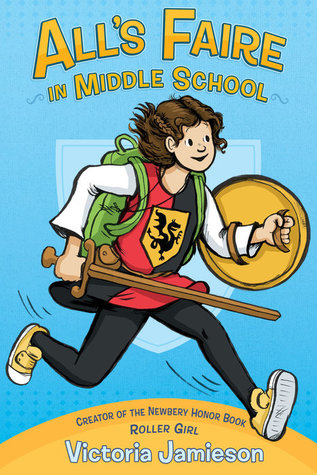
All’s Faire in Middle School hit on so many realistic middle school scenarios that I found myself cringing at times. Oh to go back to that time of trying to fit in, of figuring out who you are, and all of the mistakes you make in the process. 4th grade and up.
From Goodreads:
Eleven-year-old Imogene (Impy) has grown up with two parents working at the Renaissance Faire, and she’s eager to begin her own training as a squire. First, though, she’ll need to prove her bravery. Luckily Impy has just the quest in mind–she’ll go to public school after a life of being homeschooled! But it’s not easy to act like a noble knight-in-training in middle school. Impy falls in with a group of girls who seem really nice (until they don’t) and starts to be embarrassed of her thrift shop apparel, her family’s unusual lifestyle, and their small, messy apartment. Impy has always thought of herself as a heroic knight, but when she does something really mean in order to fit in, she begins to wonder whether she might be more of a dragon after all.

A book about a boy who loves a skunk and will do anything in his power to keep it. A book about a boy who just happens to seem different than others but without being about that. A Boy Called Bat is another Global Read Aloud contender for 2018, 3rd grade and up.
From Goodreads:
For Bixby Alexander Tam (nicknamed Bat), life tends to be full of surprises—some of them good, some not so good. Today, though, is a good-surprise day. Bat’s mom, a veterinarian, has brought home a baby skunk, which she needs to take care of until she can hand him over to a wild-animal shelter.
But the minute Bat meets the kit, he knows they belong together. And he’s got one month to show his mom that a baby skunk might just make a pretty terrific pet.
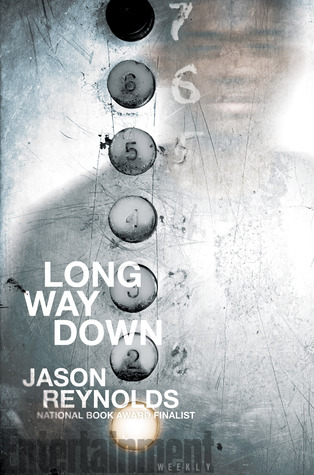
Masterful, heartbreaking, gut-wrenching, and stays with you long after that last page. Long Way Down is another absolute must-read of 2017. Global Read Aloud contender 2018, 7th grade and up, out October 17th.
From Goodreads:
A cannon. A strap.
A piece. A biscuit.
A burner. A heater.
A chopper. A gat.
A hammer
A tool
for RULE
Or, you can call it a gun. That’s what fifteen-year-old Will has shoved in the back waistband of his jeans. See, his brother Shawn was just murdered. And Will knows the rules. No crying. No snitching. Revenge. That’s where Will’s now heading, with that gun shoved in the back waistband of his jeans, the gun that was his brother’s gun. He gets on the elevator, seventh floor, stoked. He knows who he’s after. Or does he? As the elevator stops on the sixth floor, on comes Buck. Buck, Will finds out, is who gave Shawn the gun before Will took the gun. Buck tells Will to check that the gun is even loaded. And that’s when Will sees that one bullet is missing. And the only one who could have fired Shawn’s gun was Shawn. Huh. Will didn’t know that Shawn had ever actually USED his gun. Bigger huh. BUCK IS DEAD. But Buck’s in the elevator? Just as Will’s trying to think this through, the door to the next floor opens. A teenage girl gets on, waves away the smoke from Dead Buck’s cigarette. Will doesn’t know her, but she knew him. Knew. When they were eight. And stray bullets had cut through the playground, and Will had tried to cover her, but she was hit anyway, and so what she wants to know, on that fifth floor elevator stop, is, what if Will, Will with the gun shoved in the back waistband of his jeans, MISSES.
And so it goes, the whole long way down, as the elevator stops on each floor, and at each stop someone connected to his brother gets on to give Will a piece to a bigger story than the one he thinks he knows. A story that might never know an END…if WILL gets off that elevator.

Kate Messner is a master story-teller and she does not disappoint in her newest chapter book, The Exact Location of Home. I ached for the longing of Zig as he searches for his father. 4th grade and up but definitely for middle school as well.
From Goodreads:
Kirby “Zig” Zigonski lives for the world of simple circuits, light bulbs, buzzers, and motors. Electronics are, after all, much more predictable than most people–especially his father, who he hasn’t seen in over a year. When his dad’s latest visit is canceled with no explanation and his mom seems to be hiding something, Zig turns to his best friend Gianna and a new gizmo–a garage sale GPS unit–for help. Convinced that his dad is leaving clues around town to explain his absence, Zig sets out to find him. Following one clue after another, logging mile after mile, Zig soon discovers that people aren’t always what they seem . . . and sometimes, there’s more than one set of coordinates for home.
There you have it, what a fantastic summer of reading it has been!
Filed under: being a teacher, books, Reading





